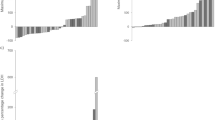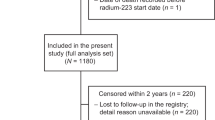Abstract
Background
Radium-223 (Ra-223) is a targeted alpha therapy that has been shown to prolong overall survival (OS) in patients with metastatic castration-resistant prostate cancer (mCRPC) with bone metastases. However, prognosis after Ra-223 administration varies among patients. The aim of the present study was to assess risk factors associated with the poor prognosis of patients treated with Ra-223.
Methods
We retrospectively reviewed patients’ records of treatment with Ra-223 between October 2016 and December 2019. All patients had mCRPC, bone metastasis, and no known visceral metastases, and received up to six cycles of Ra-223 (55 kBq/kg). Prognostic factors for OS were analyzed by Cox proportional hazards model and log-rank test.
Results
We identified 42 patients who received at least one cycle of Ra-223 (median six cycles, range 1–6). Approximately two-thirds of patients had received at least two lines of therapy for mCRPC. The median age was 74 years, and the median follow-up duration was 13.6 months. The median OS time was 16.6 months. On multivariate analysis, PSA doubling time (PSADT) (0–3 months) at baseline, number of bone metastases (≥ 20), and treatment line of Ra-223 (4th–5th line) remained significantly correlated with the poor OS (HR 4.354, P = 0.003; HR 2.855, P = 0.020; and HR 4.871, P = 0.001, respectively).
Conclusions
Our study demonstrated that a shorter PSADT, a heavier volume of bone metastases, and a later treatment line before Ra-223 are poor prognostic factors for mCRPC patients. These newly discovered risk factors may help select patients who potentially have long-term OS after Ra-223 treatment.


Similar content being viewed by others
Abbreviations
- AE:
-
Adverse event
- ALP:
-
Alkaline phosphatase
- HR:
-
Hazard ratio
- mCRPC:
-
Metastatic castration-resistant prostate cancer
- LDH:
-
Lactate dehydrogenase
- OS:
-
Overall survival
- OR:
-
Odds ratio
- PS:
-
Performance status
- PSADT:
-
PSA doubling time
- Ra-223:
-
Radium-223
References
James ND, Spears MR, Clarke NW et al (2015) Survival with newly diagnosed metastatic prostate cancer in the “Docetaxel Era”: data from 917 patients in the control arm of the STAMPEDE Trial (MRC PR08, CRUK/06/019). Eur Urol 67:1028–1038
Tannock IF, de Wit R, Berry WR et al (2004) Docetaxel plus prednisone or mitoxantrone plus prednisone for advanced prostate cancer. N Engl J Med 351:1502–1512
Kantoff PW, Higano CS, Shore ND et al (2010) Sipuleucel-T immunotherapy for castration-resistant prostate cancer. N Engl J Med 363:411–422
de Bono JS, Oudard S, Ozguroglu M et al (2010) Prednisone plus cabazitaxel or mitoxantrone for metastatic castration-resistant prostate cancer progressing after docetaxel treatment: A randomised open-label trial. Lancet 376:1147–1154
de Bono JS, Logothetis CJ, Molina A et al (2011) Abiraterone and increased survival in metastatic prostate cancer. N Engl J Med 364:1995–2005
Scher HI, Fizazi K, Saad F et al (2012) Increased survival with enzalutamide in prostate cancer after chemotherapy. N Engl J Med 367:1187–1197
Parker C, Nilsson S, Heinrich D et al (2013) Alpha emitter radium-223 and survival in metastatic prostate cancer. N Engl J Med 369:213–223
Sartor O, Coleman R, Nilsson S et al (2014) Effect of radium-223 dichloride on symptomatic skeletal events in patients with castration-resistant prostate cancer and bone metastases: results from a phase 3, double-blind, randomised trial. Lancet Oncol 15:738–746
Nilsson S, Cislo P, Sartor O et al (2016) Patient-reported quality-of-life analysis of radium-223 dichloride from the phase III ALSYMPCA study. Ann Oncol 27:868–874
Vogelzang NJ, Coleman RE, Michalski JM et al (2017) Hematologic safety of radium-223 dichloride: baseline prognostic factors associated with myelosuppression in the ALSYMPCA trial. Clin Genitourin Cancer 15:42–52.e8
Saad F, Carles J, Gillessen S et al (2016) Radium-223 and concomitant therapies in patients with metastatic castration-resistant prostate cancer: an international, early access, open-label, single-arm phase 3b trial. Lancet Oncol 17:1306–1316
Sartor O, Coleman RE, Nilsson S et al (2017) An exploratory analysis of alkaline phosphatase, lactate dehydrogenase, and prostate-specific antigen dynamics in the phase 3 ALSYMPCA trial with radium-223. Ann Oncol 28:1090–1097
McKay RR, Jacobus S, Fiorillo M et al (2017) Radium-223 use in clinical practice and variables associated with completion of therapy. Clin Genitourin Cancer 15:e289–e298
Naito M, Ukai R, Hashimoto K (2019) Bone scan index can be a useful biomarker of survival outcomes in patients with metastatic castration-resistant prostate cancer treated with radium-223. Cancer Rep 2:e1203
Epstein JI, Egevad L, Amin MB et al (2016) The 2014 International Society of Urological Pathology (ISUP) consensus conference on Gleason grading of prostatic carcinoma: definition of grading patterns and proposal for a new grading system. Am J Surg Pathol 40:244–252
Memorial Sloan-Kettering Cancer Center cancer information: prostate cancer nomogram. https://www.mskcc.org/nomograms/prostate/psa_doubling_time. Accessed 1 May 2020
The Prostate Cancer Guidelines; European Association of Urology in 2020. https://uroweb.org/guideline/prostate-cancer/. Accessed 1 May 2020
NCCN Guidelines Version 1. 2020 Prostate Cancer. https://www.nccn.org/professionals/physician_gls/pdf/prostate.pdf. Accessed 1 May 2020
Saad F, Gillessen S, Heinrich D et al (2019) Disease characteristics and completion of treatment in patients with metastatic castration-resistant prostate cancer treated with radium-223 in an international early access program. Clin Genitourin Cancer 17:348–355.e5
Antonarakis ES, Chen Y, Elsamanoudi SI et al (2011) Long-term overall survival and metastasis-free survival for men with prostate-specific antigen-recurrent prostate cancer after prostatectomy: analysis of the Center for Prostate Disease Research National Database. BJU Int 108:378–385
Oudard S, Banu E, Scotte F et al (2007) Prostate-specific antigen doubling time before onset of chemotherapy as a predictor of survival for hormone-refractory prostate cancer patients. Ann Oncol 18:1828–1833
Stewart AJ, Scher HI, Chen MH et al (2005) Prostate-specific antigen nadir and cancer-specific mortality following hormonal therapy for prostate-specific antigen failure. J Clin Oncol 23:6556–6560
Fosbøl MØ, Petersen PM, Kjaer A et al (2018) 223 Ra therapy of advanced metastatic castration-resistant prostate cancer: quantitative assessment of skeletal tumor burden for prognostication of clinical outcome and hematologic toxicity. J Nucl Med 59:596–602
Vidal M, Delgado A, Martinez C et al (2020) Overall survival prediction in metastatic castration-resistant prostate cancer treated with radium-223. Int Braz J Urol 46:599–611
Parker CC, Coleman RE, Sartor O et al (2018) Three-year safety of radium-223 dichloride in patients with castration-resistant prostate cancer and symptomatic bone metastases from phase 3 randomized alpharadin in symptomatic prostate cancer trial. Eur Urol 73:427–435
Acknowledgements
The authors wish to thank the patients and their families for participating in this study, as well as the staff for supporting the study. We also thank H. Nikki March, PhD, from Edanz Group (https://www.edanzediting.com/ac) for editing a draft of this manuscript.
Funding
None.
Author information
Authors and Affiliations
Corresponding author
Ethics declarations
Conflict of interest
KN received speaker honoraria from Astellas, Novartis and Bayer; research funding from Bayer outside the submitted work. Remaining authors declare that they have no conflict of interest.
Additional information
Publisher's Note
Springer Nature remains neutral with regard to jurisdictional claims in published maps and institutional affiliations.
About this article
Cite this article
Yamamoto, Y., Okuda, Y., Kanaki, T. et al. Clinical indicators for predicting prognosis after radium-223 administration in castration-resistant prostate cancer with bone metastases. Int J Clin Oncol 26, 192–198 (2021). https://doi.org/10.1007/s10147-020-01776-w
Received:
Accepted:
Published:
Issue Date:
DOI: https://doi.org/10.1007/s10147-020-01776-w




